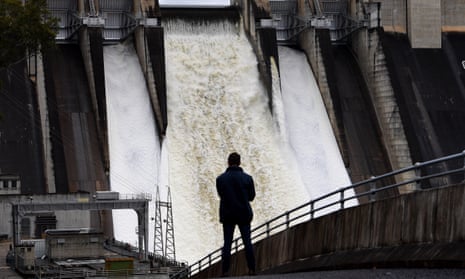After the driest winter in 37 years and with a forecast of El Niño summer, a “series of red flags” have prompted a warning about Sydney’s water use in the months ahead.
Ben Blayney, the head of water supply and production at Sydney Water, said on Monday that greater Sydney dams are at 89% capacity but “things can turn very quickly”.
“There is a perception that the dams are full and Sydney’s water supply is endless,” he said.
“What we can see as part of our daily monitoring processes is a series of red flags. These are the same trends we experienced going into the last drought.”
They include a water usage spike of 17% during the city’s last hot weekend, falling dam levels – greater Sydney dams lost 0.5% in the last week alone – and low dam inflows.
“It’s not dire straits but we’re heading into a hot summer and, with El Niño, we’re watching it constantly,” he said.
Projected depletion levels across dams, forecast using data from the last significant drought in 2020, show the city entering level 1 water restrictions at the end of 2024 and unprecedented level 4 restrictions – which need government approval – by early 2028.
As part of the effort to balance water supplies, Sydney’s desalination plant, built as a drought response asset, is now in constant use.
Philip Narezzi , the chief executive of the Kurnell plant, said the system is in 24-hour operation after changes to rules in response to climate change, population growth and network maintenance.
At maximum capacity, the plant is able to add 250 megalitres a day directly into the city’s water supply. Most of the water is directed to Sydney’s eastern suburbs and inner west, with the inflow taking pressure off the entire network, Narezzi said.
Blayney said the plant will shift to 100% capacity when dams reach a combined storage level of 75%. It runs entirely on renewable energy sourced from Capital Wind Farm in Bungendore.
The Sydney Water managing director, Roch Cheroux, said $30bn will be spent over the next 10 years to upgrade infrastructure across the network.
after newsletter promotion
According to Sydney Water data from January to March, Duffys Forest has the highest water consumption in the metro area, followed by Point Piper and Bellevue Hill. The lowest water consumption was in Berowra Waters.
The utility has enlisted Olympic canoe champion Jessica Fox as it ramps up a public awareness campaign on water use.
“Everyone needs to understand the future of water depends on all of us,” Fox said. “It’s easy to take water for granted, but with a changing climate and a growing population, the time has come for us to tackle demand.”
The New South Wales water minister, Rose Jackson, said “we all have a role” in safeguarding Sydney’s water future in a changing climate.
Blayney added: “Sydney’s a growing city. We have to get the message out. If we manage this like a community together, we can get ahead of the curve. We can’t avoid everything and if we go into drought, we’ve done the best we can.
“We are a land of extremes so this could swing quite quickly from drought to flood, but this is all about being prepared.”
